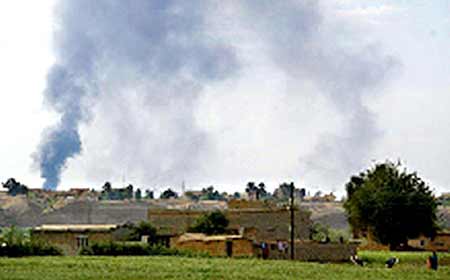The reporter, Matthew Fisher of the National Post, said Iraqis fighting Marines were in tanks, prepared for urban warfare in hopes of holding the city. Artillery explosions flashed on the horizon, and jets roared overhead. However, in Washington, Defense Secretary Donald Rumsfeld said in an interview that there was "no organized resistance" and "no organized fighting" in Tikrit. "It's relatively calm but not permissive yet," Rumsfeld told MSNBC. "A lot of people have disappeared, including the leadership of the Baath party." Al-Jazeera reported that skirmishes were raging south of the city, near Saddam's birthplace, even after local tribal groups offered to negotiate a "peaceful solution" with U.S. forces and hand over some Baath Party leaders in the city. Tikrit, 90 miles north of Baghdad, is the last major city with organized and substantial resistance by Iraqi forces. After the fall of Baghdad last week, U.S. war commanders cautioned that Saddam's regime might try to hold on ferociously to Tikrit. But they played down that possibility in recent days because of desertions and damage from sustained airstrikes. Gen. Tommy Franks, the war commander, said some Marine units entered Tikrit after a swift advance from Baghdad, but he would not say how far the Marines had gotten. Prior to the Marines' arrival in Tikrit, live footage aired by CNN showed no signs of active Iraqi defenses, suggesting that intensive U.S. airstrikes had achieved their intended effect. However, CNN vehicles came under small-arms fire as they tried to enter the city center Sunday. A CNN security guard returned fire at least twice, and the news crew quickly drove away. Many of Tikrit's streets were almost deserted. Unlike in other major Iraqi cities, the many portraits, banners and statues of Saddam remained undamaged. The main bridge to the city from the east had two gaping holes in it, but very few damaged buildings were visible during a drive through part of downtown. On the road connecting Tikrit and Tuz Khurmatu in the east, there were many abandoned checkpoints, bunkers and foxholes, as well as an abandoned artillery position. Planes zoomed overhead, and two plumes of smoke could be seen rising in the sky - one in the north and another in the south. Businessman Khalef al Ahbad said Tikrit had just endured four days of bombing. "Tikrit is a developed city, it's full of culture," he said. "We do not have a taste for blood, we are not fighters. We are thirsty for peace. America is attacking us for its own purposes. We are a peaceful people." One man, Ali Abdullah, said U.S. Special Forces were in the city for five hours Friday. He added that four or five American tanks entered and that he heard a lot of bombing and shelling Saturday morning. "Be careful," he told a reporter. "Some of the Syrian suicide bombers are here." There were no reports of looting or evidence of it in Tikrit. Stores were empty, but people said this was in anticipation of looting. "We like Saddam Hussein and he has educated our people and we will support him to the end," said Abdul al Jabouri, part of a large group of men gathered at a gas station. However, another man approached and said, "Long live the United States."
|
